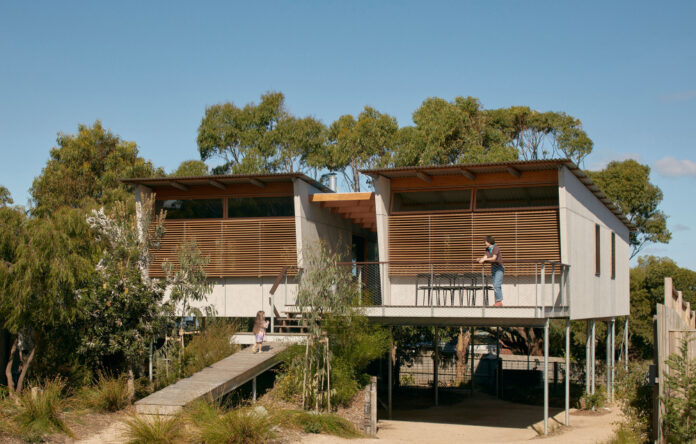[ad_1]
An Elevated 100sqm Beach Shack That Champions Passive Design
Sustainable Homes

The Eucalypt House by Not All Architecture has been raised off the ground to optimise light and views. Photo – Tom Ross.

Recycled Messmate flooring by Timber Zoo. Photo – Tom Ross.

A ramp leads up to the house and through to the internal verandah. Photo – Tom Ross.

Dining table by Not All Architecture. Photo – Tom Ross.

A Miele oven blends seamless into the kitchen space. Dining table by Not All Architecture. Photo – Tom Ross.

Double glazed windows, doors and skylights in the house by Pickering Joinery help to regulate the home’s temperature. Photo – Tom Ross.

The built-in lounge is by Not All Architecture. Photo – Tom Ross.

Side table and coffee table by Made Studio. Photo – Tom Ross.

The internal verandah acts as a divide between the living and sleeping hubs. Photo – Tom Ross.

Artwork by Gordon Lingard. Photo – Tom Ross.

Eucalyptus plywood has been used for all the interior lining. Photo – Tom Ross.

Taps by Sussex. Photo – Tom Ross.

The house has solar, swales and water collection to minimise the home’s impact on the environment. Photo – Tom Ross.
Despite its relative newness (having been completed in 2020) Eucalypt House in the Jan Juc valley, Victoria, by Not All Architecture blends seamlessly into its neighbourhood of typically modest beach homes. In fact, the small, robust home evokes a strong sense of nostalgia for all who visit it.
The home was designed by architect Phoebe Clarke, who worked within tight budget and site constraints to create a home that champions passive design, and celebrates its environment.
“The building is our attempt at expressing attributes of the traditional beach shack in newly considered ways,” she explains.
Phoebe was initially met with a house that had poor thermal performance and orientation, and due to the topography of the site, a very dark interior. Her plan was to design a home that optimised the potential of the small site; its views of the ocean, surrounding gum tree canopy and the Jan Juc valley, plus its position for solar and wind access.
“The design was established to be very site specific,” Phoebe says. “The footprint was kept compact to achieve the strict budget, and the angular living and sleeping wings of the building splayed out to best work with the site’s shape and aspects.”
The architect’s first priority was to elevate the house for optimal orientation for sun; with the bedroom facing the east, the living room facing north, and the entertaining areas facing west. This not only opened up the living spaces to the surrounding tree canopy, but also revealed a greater scope of land to be used for a garden. The owners, who both have green thumbs, were determined to allow for a generous garden, to regenerate as much of the site as possible with indigenous flora, with areas to propagate seedlings for land care, and to grow a large variety of trees and vegetables.
The next priority was to open the house up to make the most of its 100sqm footprint. “The intention was to take a very small footprint, and create a comfortable solution to small spaces,” Phoebe says.
The verandah, traditionally placed around the perimeter of the house, was repositioned right down the middle of the home, acting as both open-hallway and entry point. This undercover space serves the dual purpose of interior and exterior living, inviting sea breezes and captivating views in, and, most importantly, facilitating the acoustic and physical separation of rooms within the small footprint of the house. It also offers an outdoor living space that can be used at anytime – not just in perfect, summery weather.
The home is also designed for passive energy consumption, and the internal verandah helps to facilitate this. In summer, the space draws heat out of the rooms, acting as a cooling system. But it’s not the only temperature moderator; heat is also controlled by custom-made operable louvre screens, which are used on the north-west side of the house to block the heat of the sun in summer. In the cooler months, these screens are opened to allow the sun to permeate the living spaces. Nobo Electrical Panel Heaters, which run off a Solar Panel PV system, and an Australian-made nectre wood fireplace both also provide heating for the house.
“There was a lot of joy in being involved in this build’ says Phoebe, who describes many valuable takeaways arising through the building process. “Such as, the importance of craft and a deeper understanding of how things go together, where materials come from, their coupling and their performance’.
Finally, in addition to optimising thermal performance, the architects and builders constructed this house with a clear plan to reduce building waste. During the build, the house was established on a construction grid of 1200mm to reduce offcuts of materials. In fact, there was such little waste, that no skip was required for the entire build!
Along with solar capability, swales (which collect run-off roof water at the end of the property, and then are used to gravity feed the garden) and water collection, sustainably sourced materials, paints and finishes ensure this home’s thoughtful construction doesn’t compete with or impact the environment it sits on, but rather, works in harmony with it. An exemplary project, in every way!
[ad_2]
thedesignfiles.net










